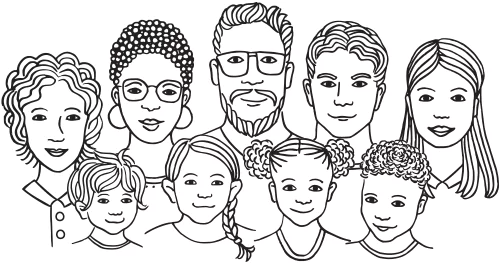What they need and why we need it too
#TheMomentofTruth

We’re calling it a paradigm shift and unprecedented, the swing from “safety response” to “safety prevention” in child welfare practice. The prevention lens we’re gazing through is of course the Family First Prevention Services Act (FFPSA) signed into law on February 9th, 2018. While the law itself is yet somewhat new and includes the biggest change to federal child welfare finance since the establishment of the Title IV-E entitlement in 1980, the core tenets are very simple and nothing new at all. To offer a simple interpretation of the law, families need to be supported, children and youth need to be connected to be safe and well, and communities have a significant role in giving them what they need.
What they need is what we all need. Every one of us needs to rely on supports from time to time; we all need our neighbors, friends and family to lend a hand in times of need. Many of us are fortunate enough and don’t even bat an eye when our kids need to be picked up from school or sports by someone other than us, their primary caregivers… most of us have “back-ups” if we need to rely on them. Imagine being a parent with no back-ups. Imagine not having anyone to call in a pinch. These are many of the families we see in child welfare services... they are the families that make it to our door because most often they don’t have other doors to knock on.
"Child welfare is all of us caring for all of them.”
In Kijita (Wajita), there is a proverb which says “Omwana ni wa bhone”, meaning regardless of a child’s biological parent(s) its upbringing belongs to the community.

Community is more than neighborhoods and buildings, community is people… people need people. The village we refer to as the African proverb is believed to reference, is a real thing. It really does take the village, our communities, to support children and families and support the safety and welfare of all our neighbors.
When we say communities must come together in support of families… we actually mean people must come together. When we talk about serving families from within their community, or community-based services, we’re talking about the people within organizations that need to work together to develop and provide services that wrap families with what they need to be strong; considering the reality that what they need is not different from what we all need.
“It’s time for the real conversations to go beyond our inner circles.”
We need to have conversations that matter. We need to speak boldly about what we know has been a long time coming, but nonetheless, desperately needed to improve child welfare. Most of us have known for some time we’ve needed to flip the system on its nose.

Child welfare professionals have known for years kids don’t need complex systems they need families and they shouldn’t be raised by government; they need to belong. For years we have expected families involved with child welfare systems to pull themselves together in times of need and crisis, most often with no back up. We’ve expected them to dust off their trauma and go about getting their lives in order with a legal time clock ticking in the background. The well- intended policies to protect children and youth have separated siblings and caused many to grow up without supports and connections… so we ask ourselves, are we really doing better?
With nearly half a million kids and youth in foster care we know it’s time to talk about the changes that must come from the FFPSA. We know it’s time for the real conversations to go beyond our inner circles. The things we say in office hallways, in our trusted circles and among our closest colleagues must be shared and debated in places that matter. We must talk openly about laws and policies that shape our practice because lives are intertwined in the pages of these documents.
The creation of the FFPSA is a major step in recognizing that we need something different than the last nearly 40 years to serve children and families; that we need to prevent the need for foster care placement and the trauma of unnecessary separation from parents, siblings, family and community. It’s an opportunity for states to dramatically re-think how they serve children and families.
It’s an opportunity to envision new and innovative ways of serving by focusing on proactive means of strengthening and supporting rather than reactive means that separate. We need to take this opportunity to go beyond FFPSA and create more for children and families than the law requires. It’s time to be bold and courageous… to think outside the box, perhaps far outside to realize new opportunities for practice, service provision and tools that support the work.
“What does this mean for technology, stakeholders and communities?”
 Well, lots of things. As opportunities exist for states and child welfare agencies to rethink, envision, plan and do, there are certainly opportunities for others to roll up their sleeves, jump in and be part of the difference. There may be more obvious correlations between needed change within communities and among stakeholders but how should technology solutions change? Doing what’s always been done does not align with the goals of FFPSA and will not work.
Well, lots of things. As opportunities exist for states and child welfare agencies to rethink, envision, plan and do, there are certainly opportunities for others to roll up their sleeves, jump in and be part of the difference. There may be more obvious correlations between needed change within communities and among stakeholders but how should technology solutions change? Doing what’s always been done does not align with the goals of FFPSA and will not work.
These chief fundamentals must guide our technology development:
- Human Centric Design
- Subject Matter Expertise/Domain Knowledge
- Business Process Reengineering and Optimization
Again, we must think and do bold and courageous things to change the course. We need to innovate more and always consider user centric design and solutioning. We need to realize the importance of subject matter expertise and bring them to the table.
”The time is now; we all have an opportunity to be the difference.”
We need to give them more than policies require of us and more than we’ve offered them in the past. We need to rely on partners and strategize together, ways to bring more immediate solutions and expedite delivery.
About the Author
 Rachael Kerrick-Brucker, MSW iis the Associate Director of the HHS State and Local Practice division with Creative Information Technology Inc. (CITI). Before joining CITI, Rachael spent 21 years in public child welfare working to make a difference for kids and families in Illinois. Prior to joining the Illinois Department of Children and Family Services (IDCFS) in 1997, Rachael worked in the private sector as a child welfare caseworker and later served as a caseworker at IDCFS where she held various other positions, including Deputy Director of Permanency Practice and Associate Deputy Director of Information Technology Services.
Rachael Kerrick-Brucker, MSW iis the Associate Director of the HHS State and Local Practice division with Creative Information Technology Inc. (CITI). Before joining CITI, Rachael spent 21 years in public child welfare working to make a difference for kids and families in Illinois. Prior to joining the Illinois Department of Children and Family Services (IDCFS) in 1997, Rachael worked in the private sector as a child welfare caseworker and later served as a caseworker at IDCFS where she held various other positions, including Deputy Director of Permanency Practice and Associate Deputy Director of Information Technology Services.
Rachael was an active policy writer and co-authored various key policies in Illinois, worked closely with the agency’s Office of Legislative Affairs, and was a significant contributor to policy on safety and risk assessment, family finding and kin connections, foster youth bill of rights, and enhanced permanency practice. Rachael was a child welfare certified trainer and contributor to numerous staff development curricula. Rachael was a lead subject matter expert on the Illinois SACWIS and served as the product owner of IDCFS case management systems. Rachael led the Illinois Technology Advancement Stakeholder Committee (ITASC) formed to improve practice through child and family centered technology. Rachael continues to serve child welfare in her role with CITI as part of a talented and dedicated team collaborating to make a difference.